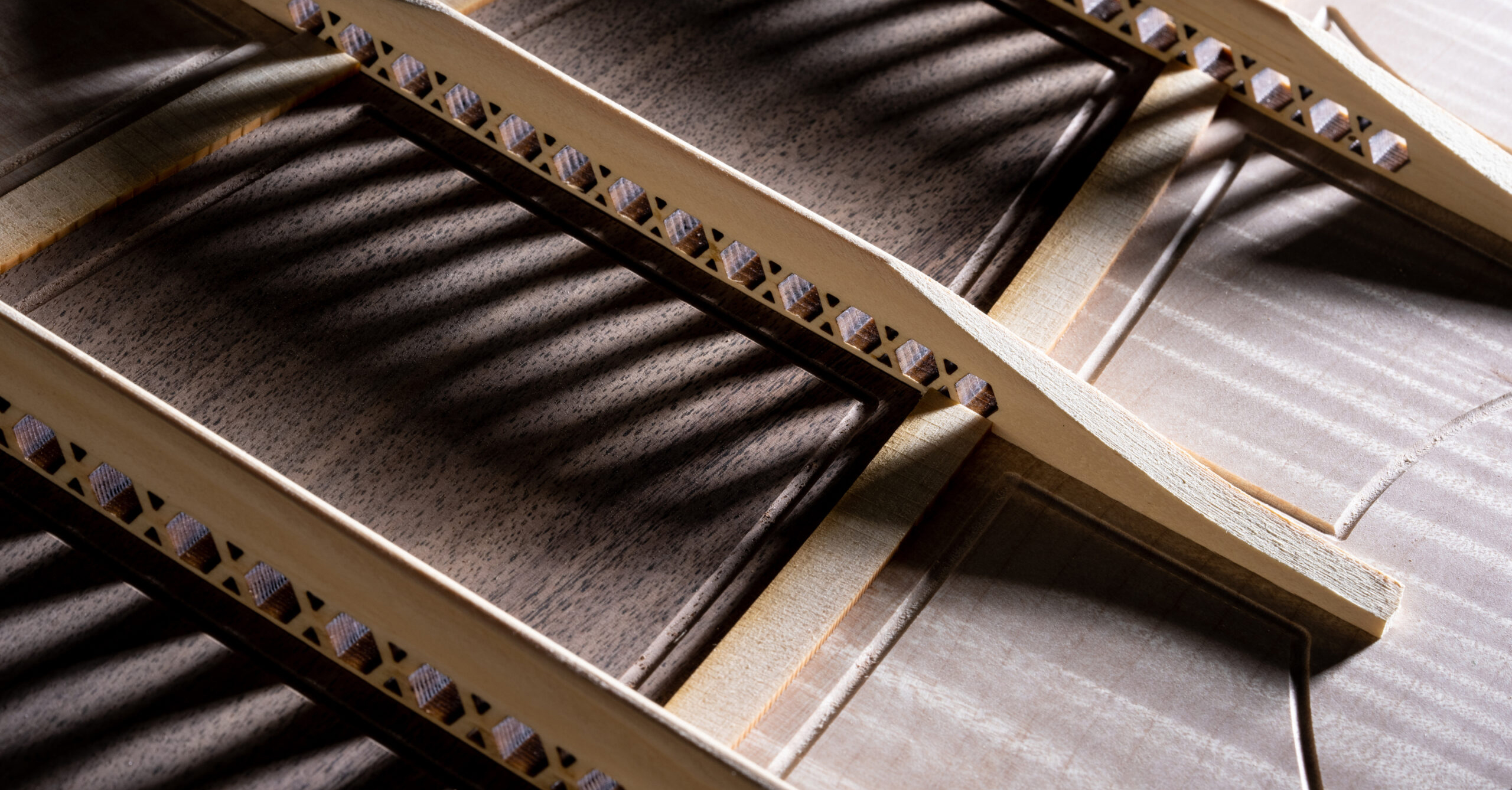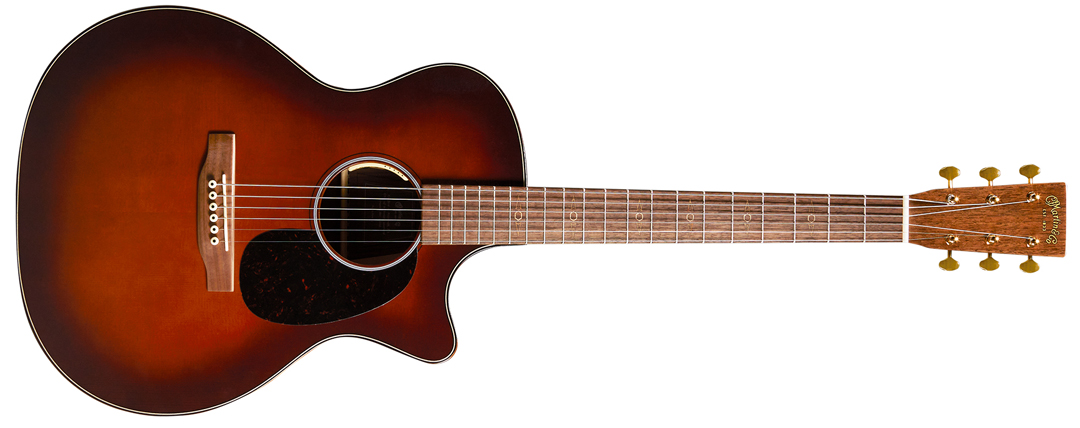The Martin GPCE Inception Maple is a Marvel
The first installment in a new series dedicated to showcasing plentiful domestic American timbers
Martin GPCE Inception Maple specs include all solid tonewoods throughout; Grand Performance body size with a cutaway; FSC certified European spruce soundboard with 5/16″ skeletonized scalloped bracing; American maple sides and a three-piece back of maple and American black walnut supported by new skeletonized back braces; black walnut neck with Modified Low Oval profile and full-size dovetail neck joint; black walnut fingerboard with High Performance taper, 1-3/4″ width at the bone nut and 2-1/8″ width at the 12th fret; black walnut bridge with 2-5/32″ string spacing at the Tusq saddle designed to work well with the LR Baggs Anthem onboard electronics; black walnut body binding; satin amber fade sunburst finish on the top, back, and sides; hex and arrowhead maple fret position markers; gold open back Grover tuning machines; molded hard shell case.
“The GPCE Inception Maple has excellent string-to-string balance that one expects from maple, but with extended sustain, satisfying warmth in the low-mids, and a fullness to its body resonance that is indeed Martinesque.”
American Maple Marvelously Martinized
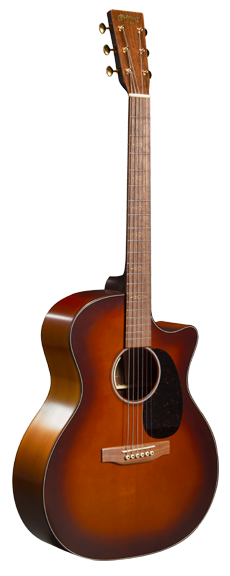 The Martin GPCE Inception Maple is made with the Grand Performance body size that has a Cutaway treble bout and onboard Electronics. Part of the Inception Series, Maple refers to the solid American maple used for the sides and two-thirds of the back. It is the inaugural model in the new series dedicated to utilizing plentiful domestic American tonewoods as well as other environmentally friendly materials, which according to the label inside the guitar are “sourced around the world.”
The Martin GPCE Inception Maple is made with the Grand Performance body size that has a Cutaway treble bout and onboard Electronics. Part of the Inception Series, Maple refers to the solid American maple used for the sides and two-thirds of the back. It is the inaugural model in the new series dedicated to utilizing plentiful domestic American tonewoods as well as other environmentally friendly materials, which according to the label inside the guitar are “sourced around the world.”
The center plate of the three-piece back is made of American black walnut, as are the fingerboard, bridge, and body binding, while the fret position markers on the fingerboard are made from figured maple. In other words, the aesthetic focuses very much on beautiful wood.
The new satin amber fade sunburst finish introduced on this model is applied to the top, back, and sides, but still allows the attractive wood grain to show through nicely. Unusual for a Martin, I have always liked that overall sunburst look on prewar Gibsons and of course various electric guitars from builders like Fender and Paul Reed Smith.
The GPCE Inception Maple is after all an acoustic-electric guitar that will likely appeal to players who spend a lot of time performing in public through electronic amplification, thanks to the LR Baggs Anthem pickup system with the volume and tone controls installed along the edge of the sound hole. But it should also appeal to those who rarely plug in, if ever, thanks to the satisfying acoustic tone.
Fully Acoustic
The GPCE Inception Maple has excellent string-to-string balance that one expects from maple, but with extended sustain, satisfying warmth in the low-mids, and a fullness to its body resonance that is indeed Martinesque. The warm glow of the new finish is fitting for the warm glow filling out the acoustic voice that radiates from the Grand Performance body.
Much of that sonic glow is due to a soundboard made from European spruce that has been certified by the Forest Stewardship Council as having come from forests managed in a ecologically responsible manner. The spruce is enhanced with engineering techniques designed to get the most tone out of the domestic woods used to create this unique musical instrument.
A bit wider and a bit deeper than a Martin Orchestra Model, Martin GPCs were created with versatility in mind, putting out even and ample volume while not having the girth or depth of a Dreadnought or Jumbo model, or the deep bass response that dominates the tone from of such large bodies. According to Tim Teel, Martin’s Head of Instrument Design, their target audience for this new model were singer-songwriters. But I feel it is versatile enough for lead guitarists and especially solo instrumentalists whose complex compositions require the sensitive dynamics of a classical guitar and the broader range of a steel-string guitar with ample tonal depth and breadth, and expressive harmonics.
Martin Maple
Typically speaking, maple is compressive and very good for reflecting and amplifying sound waves without adding much tonal influence. This is why it is the preferred wood for violins and celli, and many archtop jazz guitars, whose players want to hear distinct fundamental notes with great purity, but little in the way of sympathetics to compete with those main notes.
However, the historical Martin sound is known for being robust with considerable tonal influence emanating from the body resonance and famously complex harmonic overtones. How does this new maple Martin stack up to a Martin-centric ear attuned to the classic rosewood and mahogany models of the venerable Standard Series? Pretty darn well, as it turns out.
There is a roundness to the gentle throb of the bass strings when fingerpicking the GPCE Inception Maple that keeps them afloat, so they are never obscured by the solid mid-range notes and glistening trebles. Yet they have a translucent quality that gives them fullness but not thickness, body but not weight, warmth but not darkness – just mellowness. The sustain of the bass notes recedes perhaps quicker than one hears from rosewood or mahogany, but the decay lingers longer than expected from a maple guitar.
In fact, it is often impossible to tell where fundamental notes die away because of how they unify with the pure, singing overtones rising up and out in all directions from the solid wood body, like I hear from my favorite Martins. And that goes for the bass, mid-range, and trebles. It is a very successful guitar in this regard, and a very successful Martin.
The mids stand out or blend in depending on how hard one plays the strings, tighter in scope than the bass notes, but still buoyant, woody, and warm. The treble notes are clean and clear, with pinpoint focus, yet triggering so much body resonance they produce a satisfying three-dimensional effect that is open and spacious, allowing a refined clarity for melody work, strums, and arpeggios, while illuminating the mids and bass with very pretty overtones that blend beautifully with the warmer woody undertone glowing up from the bottom end.
(click images to enlarge)
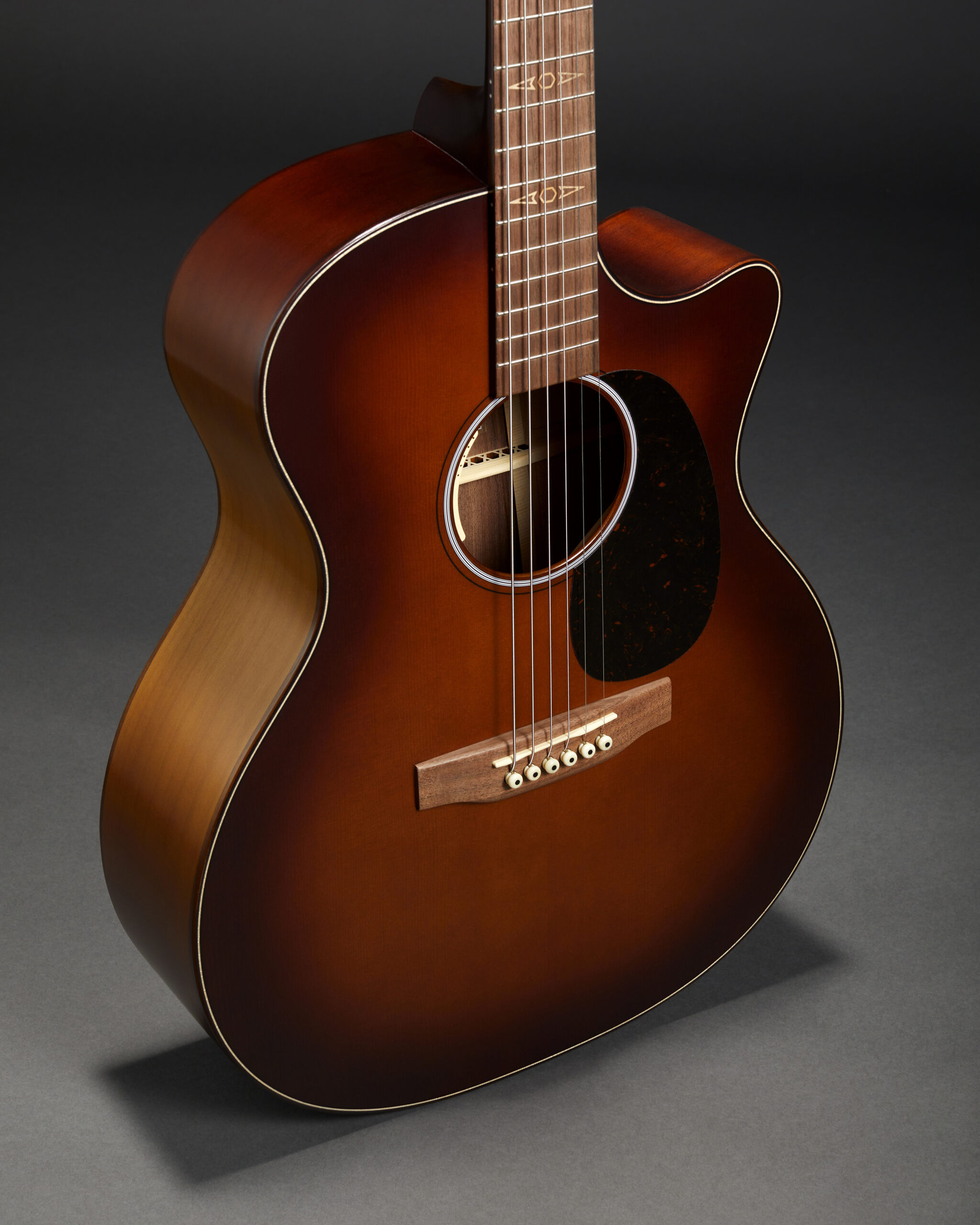 |
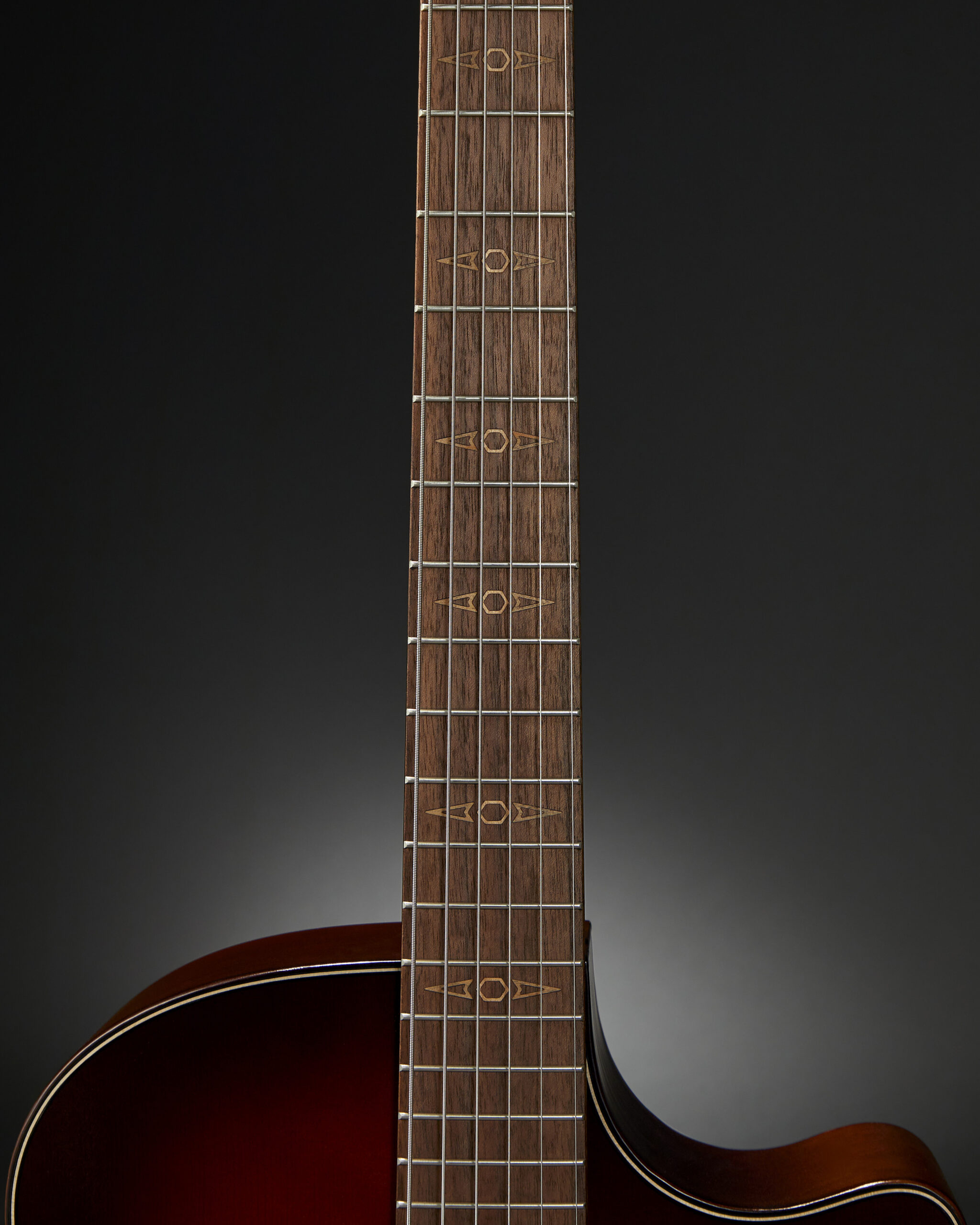 |
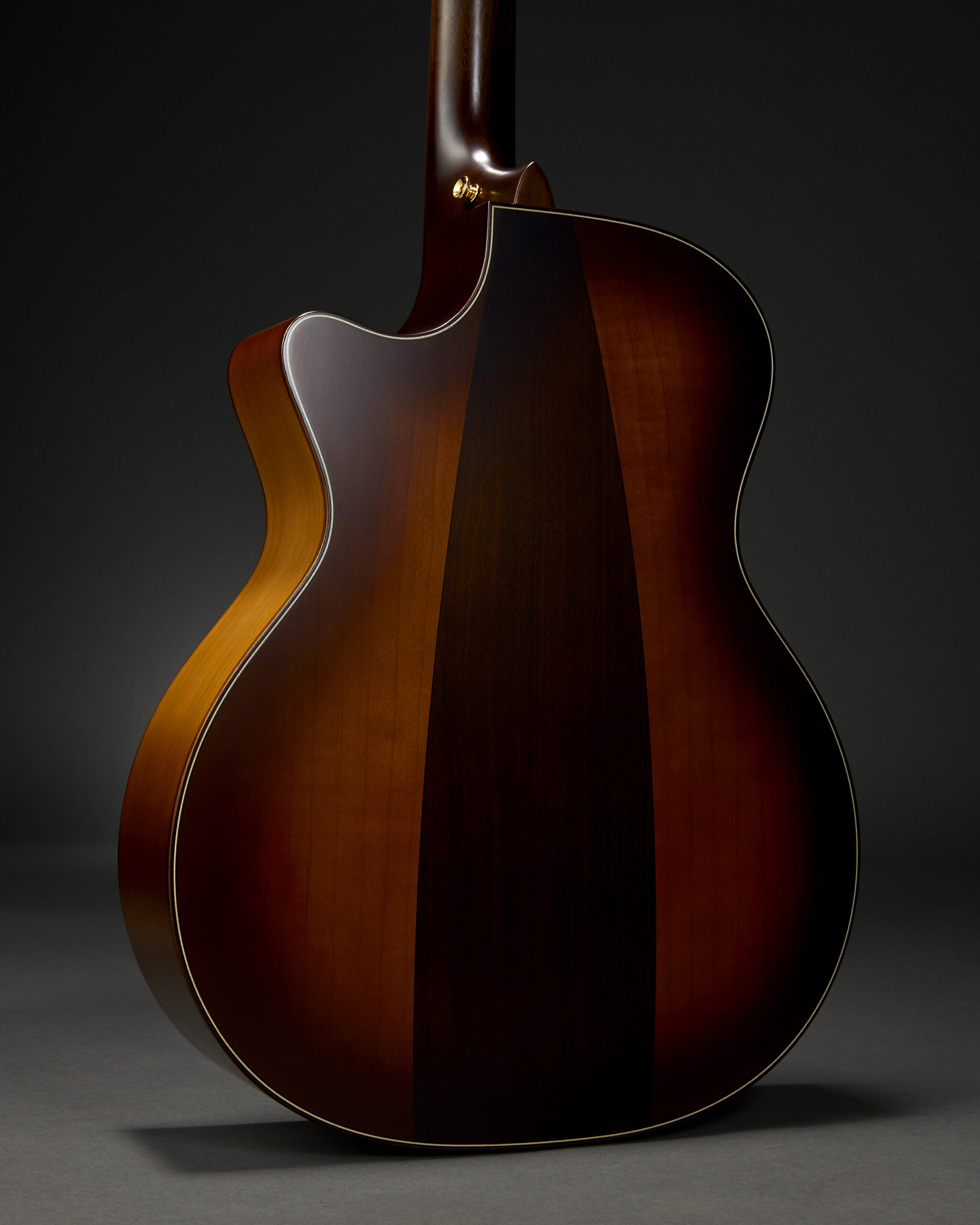 |
The satin finish certainly contributes to open airy quality to the voice, as proven by the recently added satin finish versions of the D-18 and D-28. This is not the same nitrocellulose finish found on most high-end Martins applied with less buffing, but a completely different lacquer that is also thinner, allowing the back and sides to breathe more.
It therefore does not incite the same barking projection as the full-gloss nitro lacquered models offer. So, do not be surprised if you play one of these new Inception models and find it reminding you of a Lowden guitar, when it comes to the mellow dynamics and expansive TARDIS inside the voice.
While the GPCE Inception Maple does not have the powerhouse dynamics I love in a D-18 or J-40, or the satisfying throaty growl and roar that comes from such Martins when strummed overly-hard and all that, it offers exceptional responsiveness and lively, effervescent dynamics when played with a civilized hand that allows the voice to attain and maintain optimum resonance with minimal resistance. This makes the dynamics surprisingly reminiscent of prewar OMs and 000s.
Traditional Tone
The GPCE Inception Maple also offers a wonderfully satisfying purity to the notes, which I expect from Martins made with the traditional, full-size dovetail neck joint glued into a solid wood neck block, but no longer expect to hear from every guitar sporting the Martin logo. That exceptional Martin tone is indeed heard from this new model and made all the more wonderful by a harmonic complexity to the overall voice that I really didn’t expect to hear from a “maple Martin.”
Again, when compared to other Martins in its price range, the GPCE Inception Maple does not deliver the thick, sumptuous devils food richness of Indian rosewood, nor the hearty warmth of a fresh from the oven loaf of wholegrain mahogany, nor even does it have the drier yet aurally nutritious “toasted wheat underpinnings” of sapele Martins. But what the GPCE Inception Maple does whip up is wonderfully balanced, charmingly musical, nimbly flavorful, and quite scrumptious to mine ears.
Modern Martin engineering has come up with ways to harvest tone with genuine character and complexity from a plentiful tonewood often accused of sounding anemic to Martin-loving ears. That is a very good thing to do in a world facing the utter annihilation of the few exotic tropical timbers that luthiers have relied on to make flattop acoustic guitars. The Martin GPCE Inception Maple is an environmentally-friendly acoustic guitar that has genuine Martin tone. But how did they do that?
Convergent Enhancements
The roundness and warmth in the tone can be attributed to a combination of specs. (Martin is very good at introducing multiple new things on new models so it is not easy to pin down what is causing what when it comes to tone.)
Walnut
First, there is the back centerpiece of American black walnut, the shape of the plate and the specific species having been chosen after much experimentation. It is stationed directly across from the bridge plate and sound hole, to absorb and reflect the sound waves and inject some sonic pigments into them.
The influence of walnut on the tone of this new model, often cited as sounding somewhere between rosewood and mahogany, is immediately obvious. It still has a primarily maple voice, just with more going on therein, compared to other maple guitars offered by flattop acoustic guitar makers in places other than Nazareth, PA.
Kovar Strings
Then there are the new Luxe Kovar strings, with the wrap wire made from a nickel-cobalt alloy, which lack the sonic sheen of typical phosphor-bronze strings, and thankfully lack pb’s raspy string noise as well. Designed to be anti-corrosive without the need for coatings or other string treatments, they also sound a bit like strings that have been played in a while and lost their new string pizzazz. Perhaps this makes them a good choice for someone trying to reduce the brightness of a particular guitar. At this point I can only guess that Kovar strings likely reduce some of the brightness often heard from maple, as well as smoothing off the metallic ping from the treble timbre of new European spruce.
European Spruce
At its best, European spruce puts out a hybrid tone combining defined top notes like Adirondack spruce but also awash with a background radiation of soft-focus pastel hues that are subtler than Engelmann spruce provides, but without having to wait five years for that ethereal complexity to develop. It is that permeating European spruce essence that fills out the airy voice of this new maple Martin and takes full advantage of the new and very exciting enhancements Martin has applied to the bracing and to the inside of the back and soundboard.
Old Meets New Yet Again
Unlike the futuristic S models, such as the new SC-28E and SC-18E, the GPCE Inception Maple is made with the same full-size dovetail neck joint and classic scalloped spruce X-bracing used on the venerable D-45 and other professional-level Martins. What is different about the Inception model is how the bracing has been “skeletonized” and the top and back routed out and about with “sonic channels.”
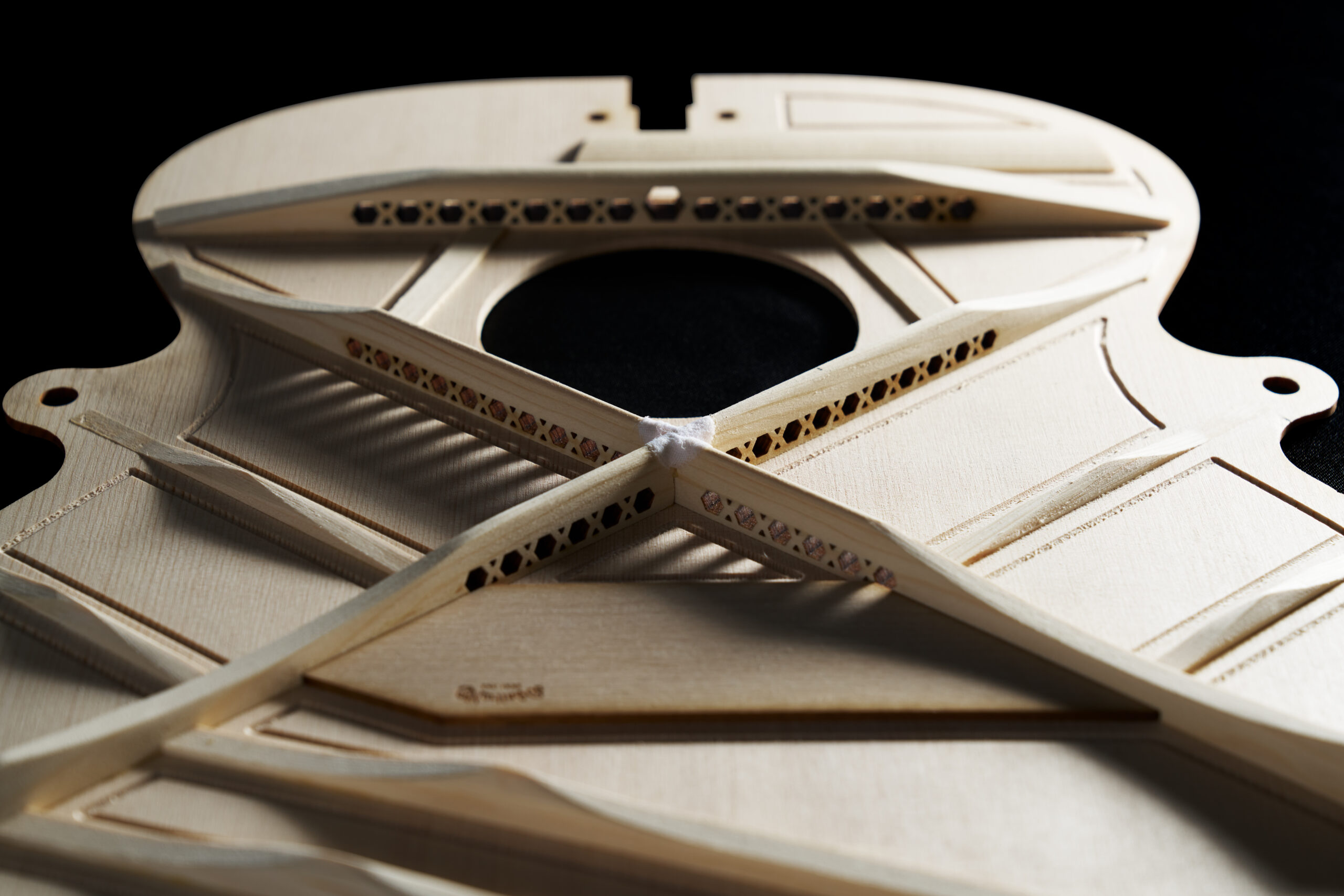 |
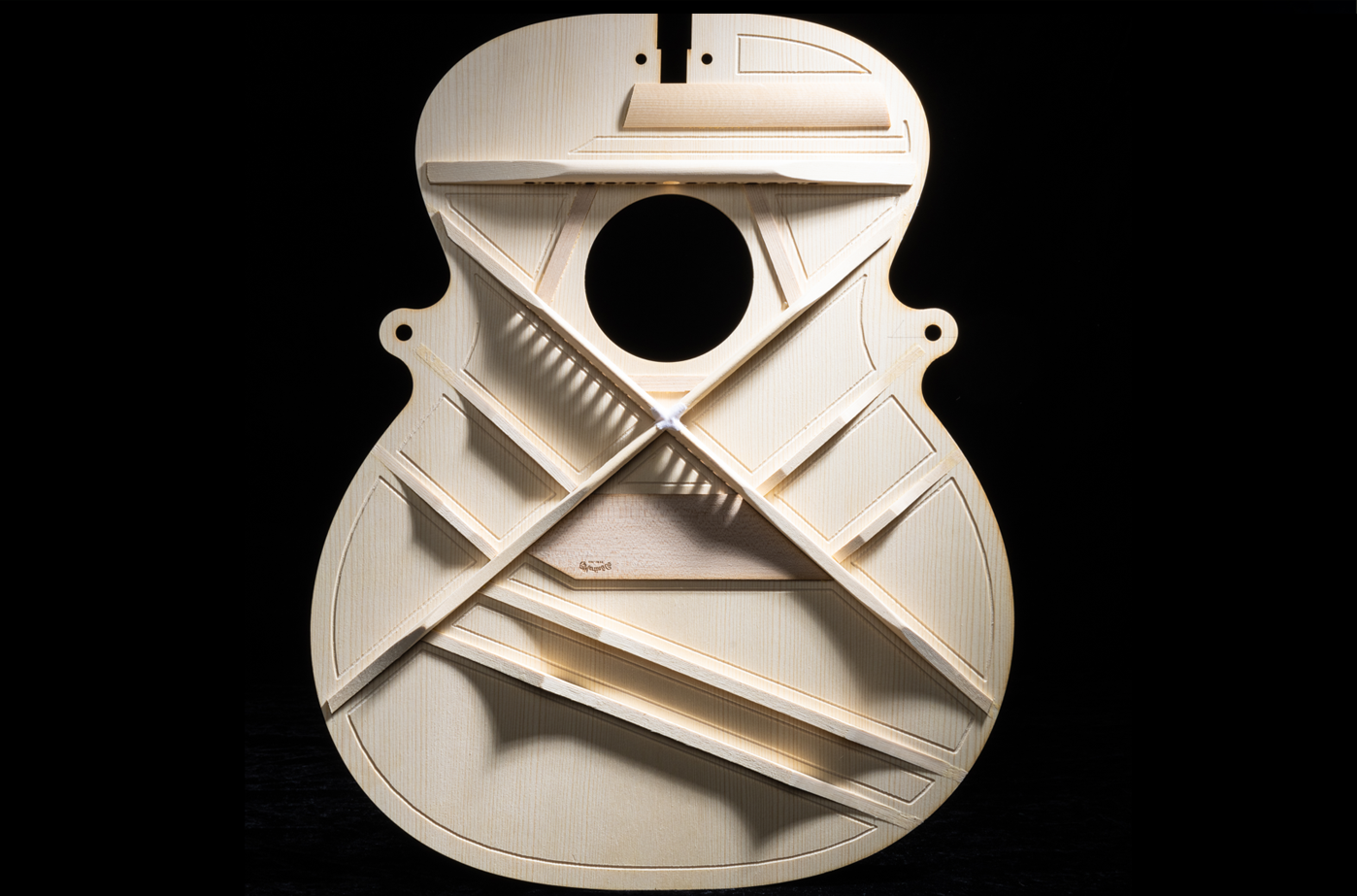 |
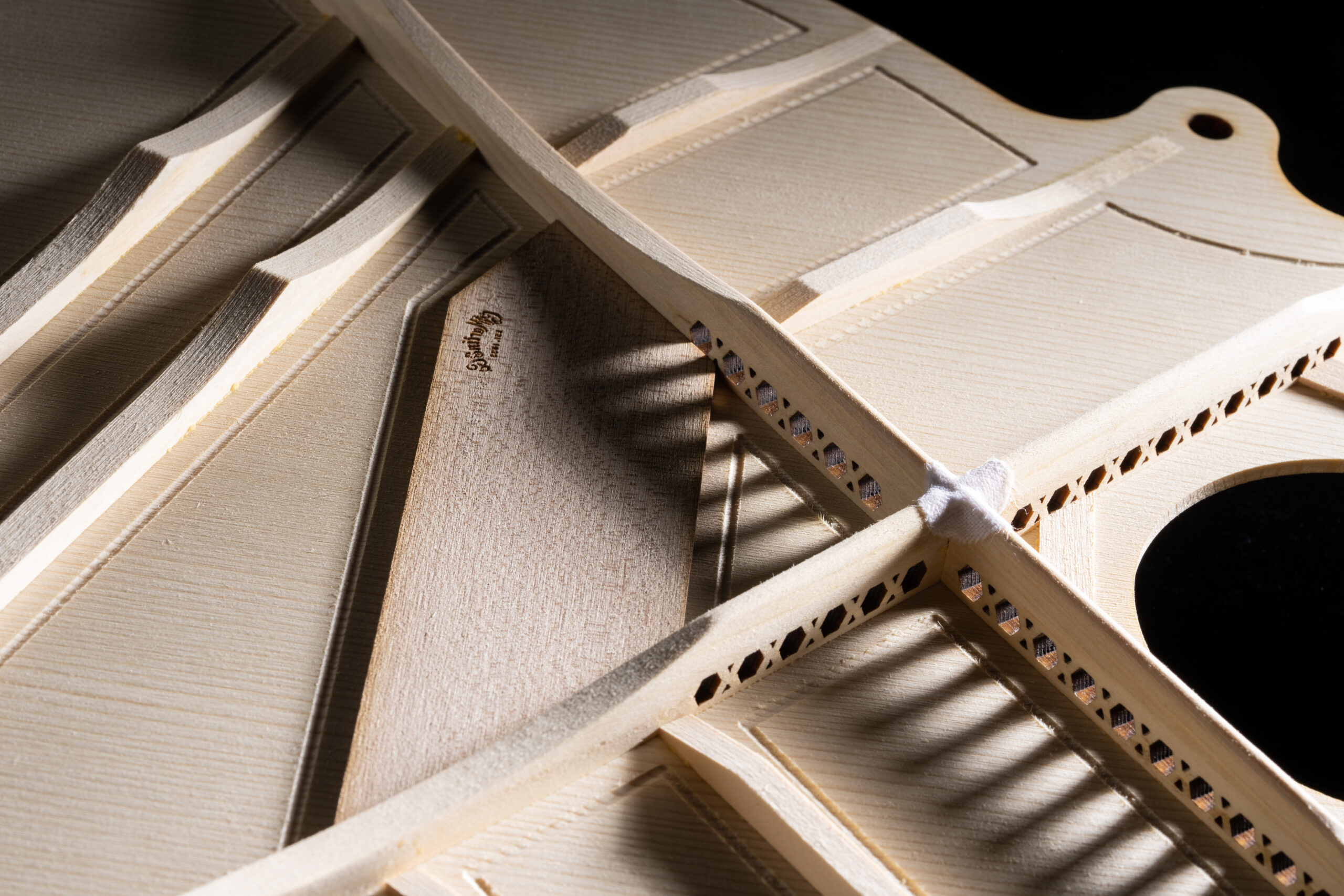 |
Holey Braces, Batman!
On either side of the sound hole resides the thickest bracing that supports the soundboard, consisting of the center of the main X brace and the large strut that straddles the two halves of the upper bout. Martin used a laser to remove mass from the highest, densest sections of these braces to increase their flexibility, so the soundboard may vibrate more freely and convert more energy into sound waves in a manner that increases volume, sustain, and tonal complexity.
Martin is not the first guitar maker to put holes in braces with similar goals. But how they have gone about it is quite interesting. The bracing struts were routed out with geometric shapes that look like little cloisters, those airy covered passageways seen at medieval abbeys and cathedrals. While pretty to look at, the shapes have a long tradition at C. F. Martin & Co.
The spaces cut into the braces have the dimensions of a hexagon, just like the center of the fret position markers inlaid on the fingerboard, and the larger hexagons used for fret markers on many high-end Martins. But as those little hex-shaped holes line up one after the other, the spruce left between them is in the shape of an X, like the X-bracing that C.F. Martin Sr. invented sometime around 1840, which resulted in the first uniquely American acoustic guitars. I saw what you did there, Martin.
Martin’s Research and Development Department did a lot of stress testing while developing these skeletonized braces to ensure they will stand up to the rigors of an acoustic guitar’s long life. They were satisfied with the strength and stability to the point they used skeletonized bracing across the entire back.
What has traditionally been little more than a structure to anchor the sides of a guitar, the back of this guitar responds with considerable fluctuation, not just reflecting sound waves, but influencing the physics of creating tone, like playing ping-pong with the sound waves served up by the spruce soundboard. How much influence that has on tone is impossible to tell, but I do know the walnut center plate on the back seems to have a lot more influence on the tone than I expected.
Channeling Tone
The other major introduction under the hood is the “sonic channels” cut into the soundboard and back plates, around their perimeters and around the individual braces, tone bars, and the bridge plate. The claim is that the area of the soundboard adhering to a particular strut or bar in the bracing will also vibrate more freely as these channels doing their localized part to increase amplitude and sustain. And the same goes for the channels cut into the back around the redesigned skeletonized back braces. Martin has the scientific data to back up such claims.

I love the fact the new enhancements were introduced to what is otherwise the exact same scalloped top bracing and same neck joint used on the Standard Series of professional-level acoustic guitars. The tonewoods are unconventional because our time in history demands that. But this is also a new way to explore traditional Martin handcrafted luthiery. It is different from the way they combined new materials and technologies with the traditional tonewoods on guitars in the Modern Deluxe Series. Multiple options available at the highest levels of guitar making is never a bad thing.
The GPCE Inception Maple certainly puts out good, pleasing tone with a modicum of effort from the player. But like many guitars made to be responsive, it does not return the power put into it when played with a vigor above and beyond its attack ceiling.
We have encountered this before, in Custom Shop Series instruments from the 20-teens, just as we encounter it in every Martin made in the 19-teens on up into the 1930s. Like those old-timers, this latest Martin has a choked throttle, in other words. But it rewards the player who lays off the throttle until the lubricated engine purrs with optimum, effortless resonance, and the gears and wheels glide effortlessly down the open road.
Modern Legacy
Since Chris Martin assumed command at his namesake company, he navigated Martin Guitar through the turbulent straights between the banks of tradition and innovation, legacy and modernity, and always with a commitment to respecting and sustaining the natural resources that our global society relies upon. Now under his Chairmanship and semi-retirement and the leadership of current President and CEO Thomas Ripsam, Martin has created what may be their best guitar yet with sustainability as its primary purpose, and it is but the first of many new Inception Series models to come.
I look forward to future Inception Series models and expect we will see them (and hear them) with American cherry and other domestic woods for the back and sides, like (possibly) sycamore, myrtle, laurel, eucalyptus, and maybe with some tops of reclaimed spruce, redwood, and ceder for that matter. I raise my glass to that.
I also hope they maintain the same neck joint and bracing on future Inception Series models that we see on this adventurous first model. Those features in combination are a bulwark of Martin guitars, not just of their past glory but of their enduring excellence.
All and all, the GPCE Inception Maple is quite different from previous maple Martins. The D-60 and the earlier D-62 Limited Edition were Martin dreadnoughts with maple back and sides, and I thought successful guitars. I’d still like to have me an MC-68 with its 22-fret neck and clear, jazz-worthy tone. But such guitars had a disadvantage when looking like and being too much like the rosewood and mahogany Martins they were compared to.
This GPCE Inception Maple is not just another maple Martin. Nor is created with the inferior but affordable construction of the old “ecological” Smartwood models (thankfully!) In this case, the efforts of the designers and R&D folks employed to create a maple Martin that still sounds like a “real Martin” have exceeded all expectations.
It is a fully realized Martin to be sure, designed for modern guitarists who desire versatility and singer-songwriters who want balanced, pretty tone that arrives effortlessly to accompany the human voice whether acoustically or plugged into the onboard electronics, where its versatility will increase. While they could have cut corners to bring the sticker price down, it is very good that Martin did no such thing.
And that is one man’s word on…
The Martin GPCE Inception Maple
$3,999.00
More photos HERE
Official Martin GPCE Inception Maple Spec Sheet HERE
Additional Reading:
Martin SC-28E and SC-18E Review with video
And check out the rare Cherry Hill Customs, also made from sustainable woods, with many Standard Series features, plus upgrades – available for sale only to onsite visitors at C. F. Martin & Co., Nazareth, PA
